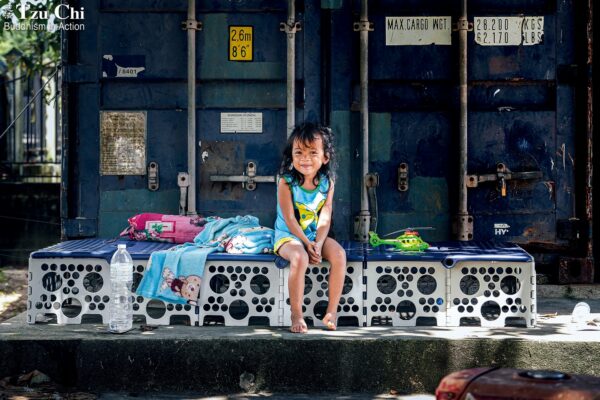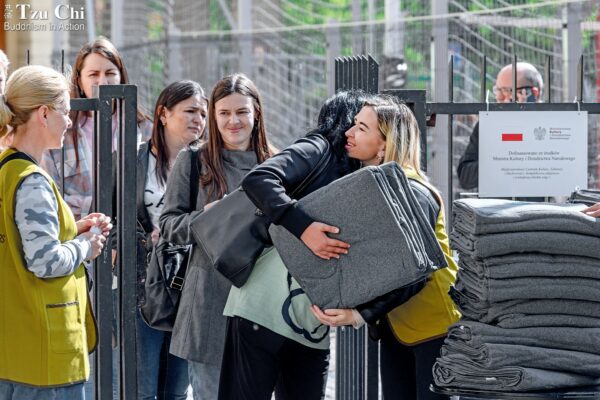By Chen Li-an
Abridged and translated by Wu Hsiao-ting
Jing Si Herbal Tea is the brainchild of a joint effort between professionals of Western medicine and traditional Chinese medicine. The health drink was developed in response to the COVID-19 pandemic and contains an effective mixture of eight herbal medicines, but its origin was in something much closer to the heart: compassion.
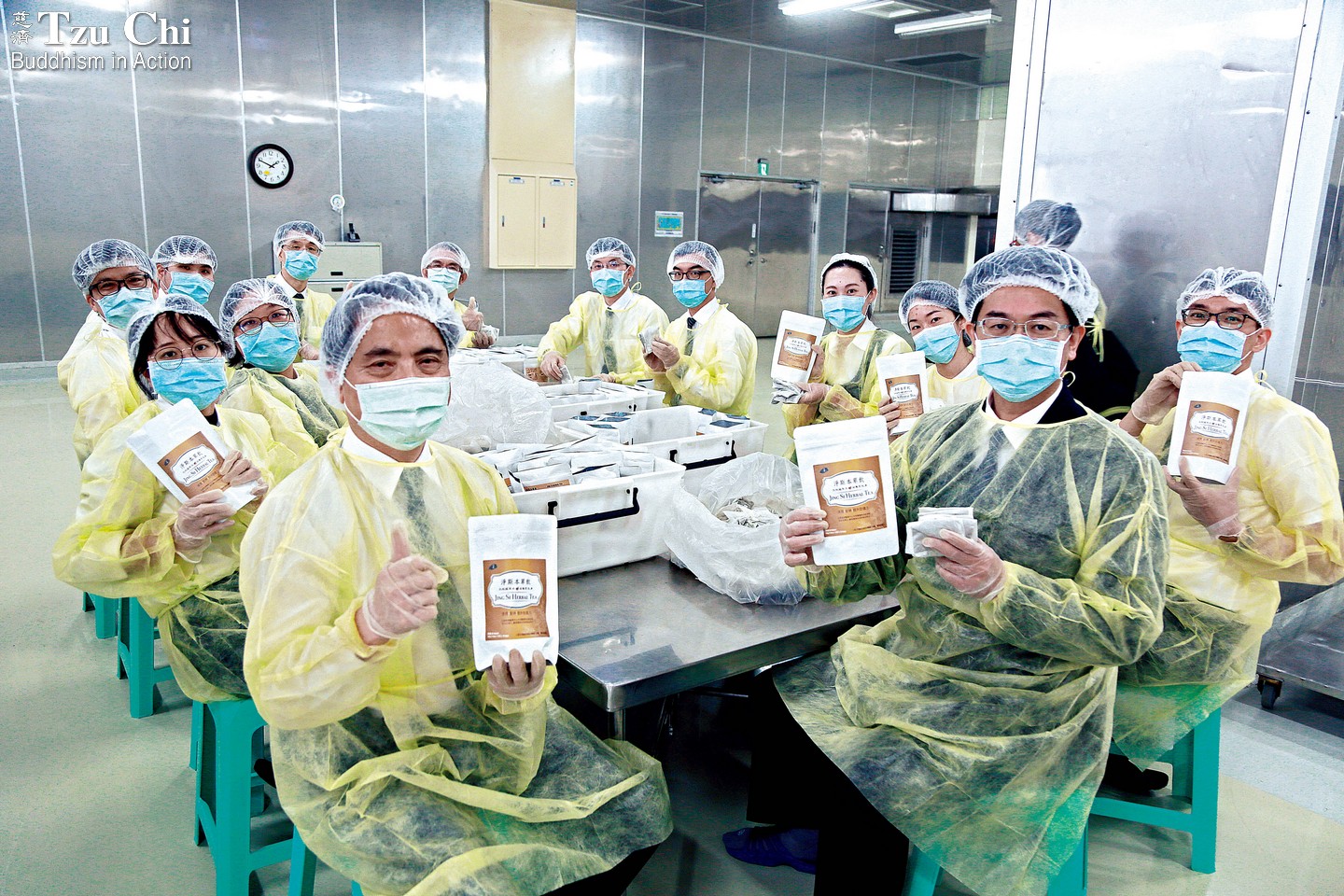
Medical workers from Hualien Tzu Chi Hospital help pack Jing Si Herbal Tea during a training event for hospital employees.
For more than a year, since the pandemic began, the Tzu Chi Foundation has donated items to front-line workers in the fight against the coronavirus. Such items have included personal protective equipment, multigrain powder, and instant rice. But in late 2020, the foundation added Jing Si Herbal Tea, a health drink, to its list of items for donation. The tea was based on a traditional Chinese medicine (TCM) compound formula developed by professionals of TCM and Western medicine at Hualien Tzu Chi Hospital, eastern Taiwan. The team that developed the drink hoped to convey with it their best wishes for a world ravaged by the coronavirus. By July 2021, Jing Si Herbal Tea had been delivered, along with other COVID aid provided by Tzu Chi, to 33 countries and regions.
Since COVID-19 broke out, healthcare experts around the world have racked their brains to think of ways to battle the virus. Specialists in traditional Chinese medicine have joined in the effort too. As a result of the latter’s efforts, a variety of anti-coronavirus health products based on TCM formulas have appeared on the market. Given that, what is so special about the herbal tea developed by Tzu Chi?
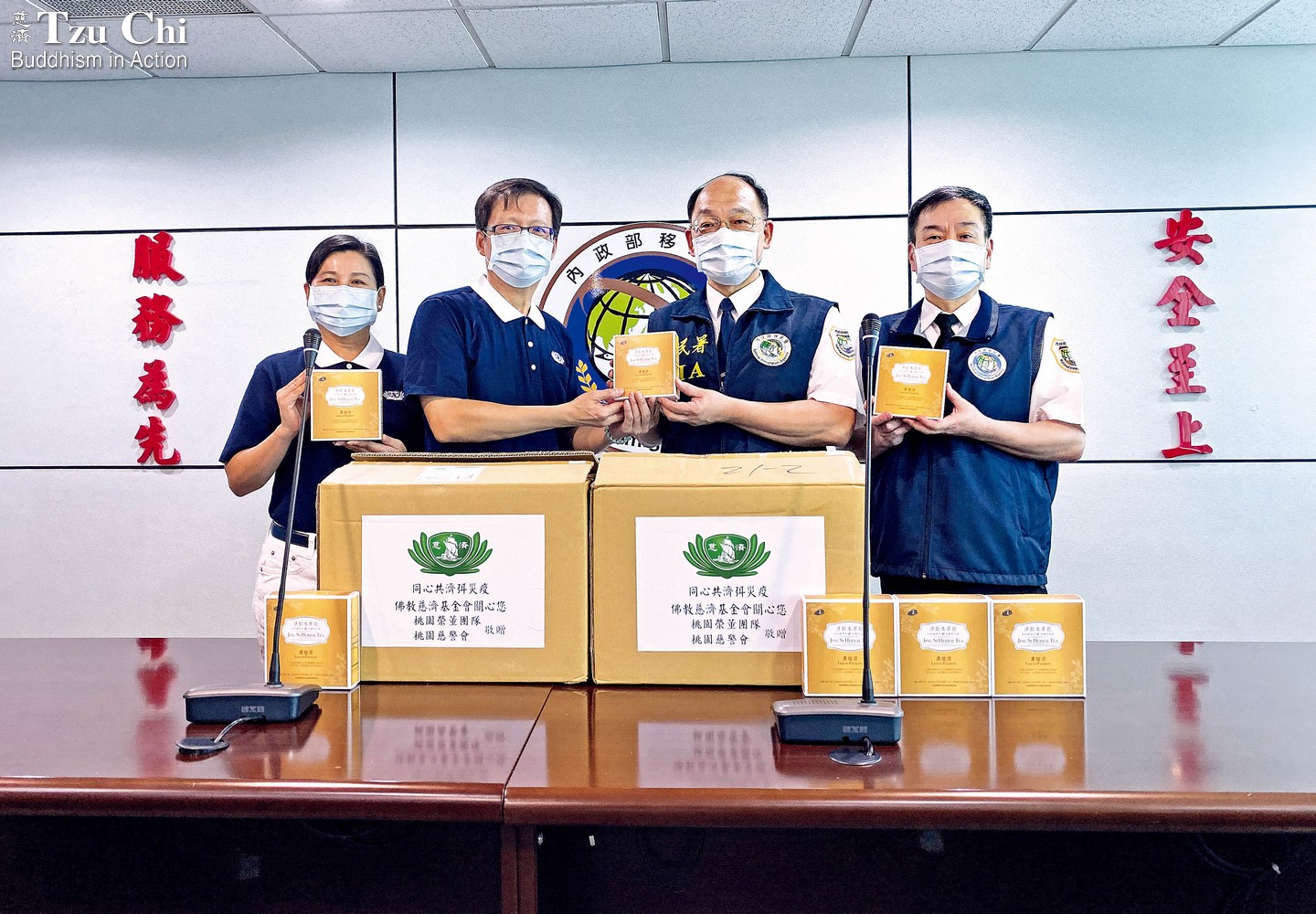
Tzu Chi donated Jing Si Herbal Tea—in concentrated liquid form—to the Border Affairs Corps of Taiwan’s National Immigration Agency. Li Ming-lin
The research project
In March 2020, when the coronavirus started sweeping the world, everyone felt anxious, fearful, and helpless. Hoping to do something to help, Dharma Master Cheng Yen asked Tzu Chi healthcare professionals to develop an herbal tea using the wisdom of traditional Chinese medicine to help protect people’s health.
In response to the Master’s request, a team was formed at Hualien Tzu Chi Hospital for research and development. The group was led by Lin Pi-yu (林碧玉), vice president of the Tzu Chi Foundation, and Lin Shinn-zong (林欣榮), the hospital’s superintendent. Other members included Ho Tsung-Jung (何宗融) and Huang Chih-yang (黃志揚), vice superintendents of Hualien Tzu Chi Hospital, as well as the TCM team at the hospital, and the research group in the hospital’s Cardiovascular and Mitochondrial Related Disease Research Center.
Vice superintendent Huang Chih-yang explained that their research objective was to develop a formula that could stop a virus from entering a cell, suppress the multiplication of a virus, regulate cytokine storms—a sudden onslaught of proteins secreted by the immune response that overwhelms the immune system—and deter tough variants. The group of health professionals first used Chinese medicinal herbs to develop several compound formulas, then tested them for their effectiveness. Vice superintendent Ho Tsung-Jung, who is also the head of the TCM department at Hualien Tzu Chi Hospital, said that the key to successfully developing such a formula was inspired directly by Master Cheng Yen.
Dr. Ho explained that when the research team was briefing the Master on the progress of their work during a meeting, she shared with them a remembrance from her childhood. She said that back when Taiwan was still an agricultural society, people believed that plants such as Chinese mugwort and Desmodium caudatum could ward off evil spirits and disease. When people went out to visit patients, clean their ancestors’ tombs, or visit grieving families, they’d pick Desmodium and take it with them. When they returned home, they’d boil some Desmodium in water and use the liquid to cleanse and purify themselves. “What people back then thought could ‘ward off evil spirits’ might actually have been effective in fighting harmful bacteria or poisonous substances,” the Master said. She suggested that the research team study those two plants to see if they did have such effects.
Following the Master’s suggestion, the team added the two herbs to a formula they were working on and conducted tests on it. “The test results showed that the addition of those two plants heightened the effects of the formula in stopping a virus from entering a cell,” said Dr. Ho. “It really came as a great surprise to us.”
The final herbal tea formula the group’s research eventually produced contained eight ingredients. In addition to the two plants mentioned above, other components include mondograss, fish mint, platycodon, Chinese licorice, perilla leaves, and chrysanthemum. Dr. Ho shared that the research team discovered that these herbs complement one another when used together, each working better than if they were used alone.
Ho added that traditional Chinese medicine stresses the importance of balancing yin and yang (roughly, “darkness and light”). When yin and yang are in balance, good health follows. “When a person lacks positive energy, they need ‘yang’ to boost it,” he observed. Using the eight herbal ingredients of the Jing Si tea as an example, he explained that when the ingredients are combined, they work to “support the positive and eliminate the bad.” The brew is good to drink regularly to protect one’s health.

South Africa has been the African country hit hardest by the pandemic. In early March 2021, a Tzu Chi rehabilitation facility in Tembisa, Johannesburg, reopened. Volunteers there received Jing Si Herbal Tea—in tea bag form—sent by Tzu Chi headquarters in Taiwan. Courtesy of Tzu Chi South Africa
Its purpose is to help people
Though Jing Si Herbal Tea is made purely from Chinese herbs, the Master often expresses her wish that Chinese and Western medicine can complement each other. That’s one reason she puts a premium on studying Chinese herbs.
Dr. Ho explained that many medications used in Western medicine are made from herbs employed in Chinese medicine. Examples include shikimic acid, extracted from star anise to use as an ingredient in flu medicine, and artemisinin, extracted from the plant Artemisia annua, also known as sweet wormwood, to make anti-malarial medicine. Even Superintendent Lin Shinn-zong, a Western medicine practitioner specializing in neuroscience and neurosurgery, once used extracts from Chinese angelica, an herb commonly used in TCM, as one of the ingredients in the development of a new medicine.
Ho admitted that when they first launched their research project, many people doubted they would succeed. Such misgivings came from all quarters—those practicing Western medicine, others following traditional Chinese medicine, even Tzu Chi volunteers themselves. Despite such doubts, the research team threw themselves into the project and did their very best. They knew it was the Master’s compassion, her wish to help boost people’s health and ease suffering during the pandemic, that had launched the project. “The purpose of the drink was to help people, not to make profits,” Ho said. Resonating with such thoughts, the team went all out and eventually brought the project to fruition.
“When I asked some nuns at the Jing Si Abode [the Buddhist convent founded by Master Cheng Yen] where to obtain the herbs to make the drink in large quantities,” said Ho, “they told me, ‘They’re already being grown.’ I asked them where the seeds had come from, and they said Tzu Chi volunteers had provided them for free.” Within two months, the herbs grown to make the drink were being harvested. “We were impressed by the efficiency of everything,” Ho added. Production of the drink was fast-tracked so it could be used to help people as soon as possible.
In addition to the herbs grown on Tzu Chi farms, other herbs used to make the drink are purchased from all over Taiwan. Jing Si Pureland Company was responsible for the drink’s volume production. Jing Si Herbal Tea is now available to the public in powder, concentrated liquid, and tea bag forms. It is safe to ingest and has almost no side effects.
Everyone who has participated in the invention and production of Jing Si Herbal Tea hopes to help safeguard the public’s health and contribute to the well-being of people suffering due to the pandemic.
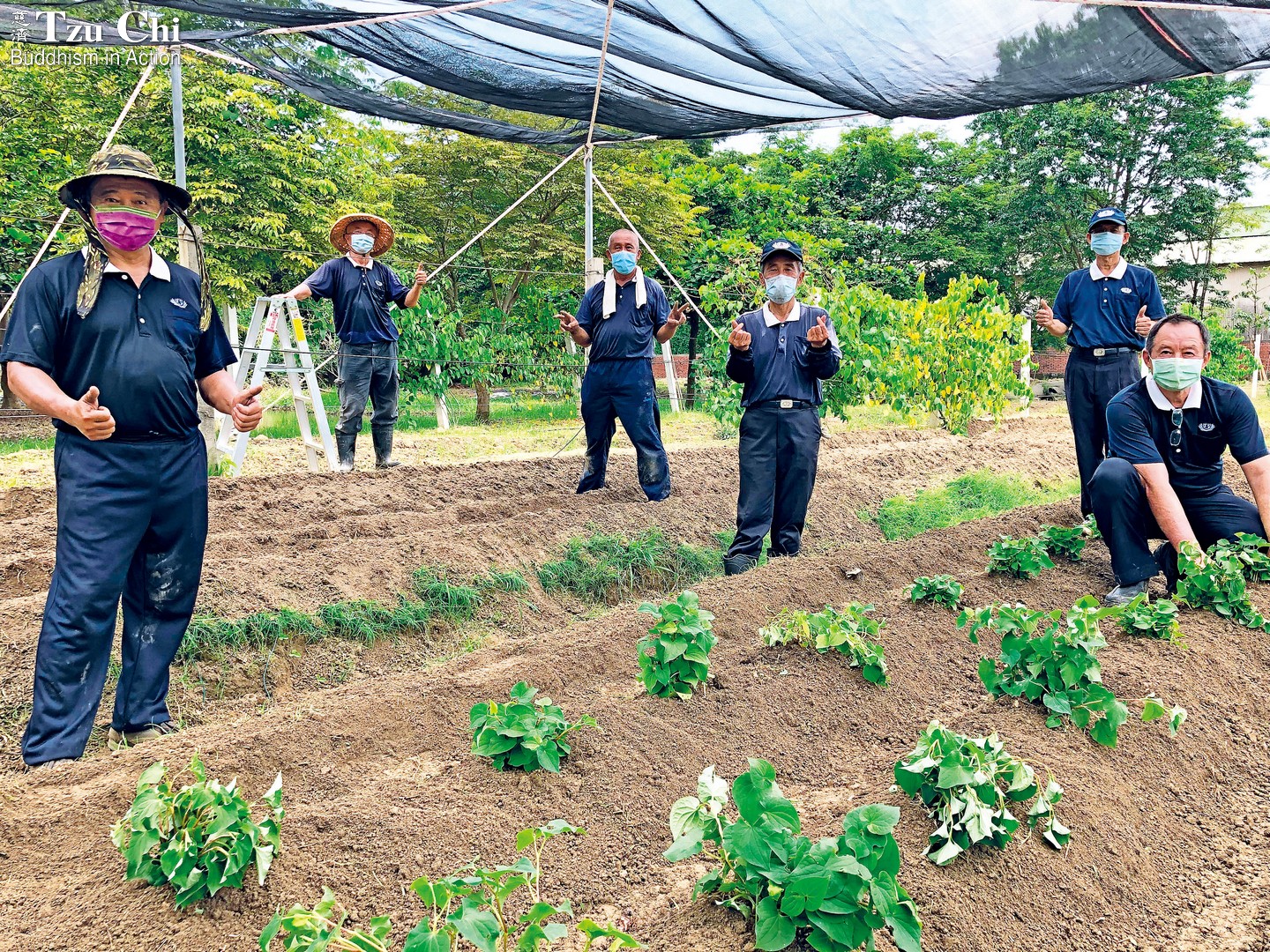
Under the guidance of experts, volunteers planted fish mint and Desmodium caudatum at the Tzu Chi Gangshan Campus, southern Taiwan. The herbs are two of the ingredients of Jing Si Herbal Tea. Wang Fu-shou

